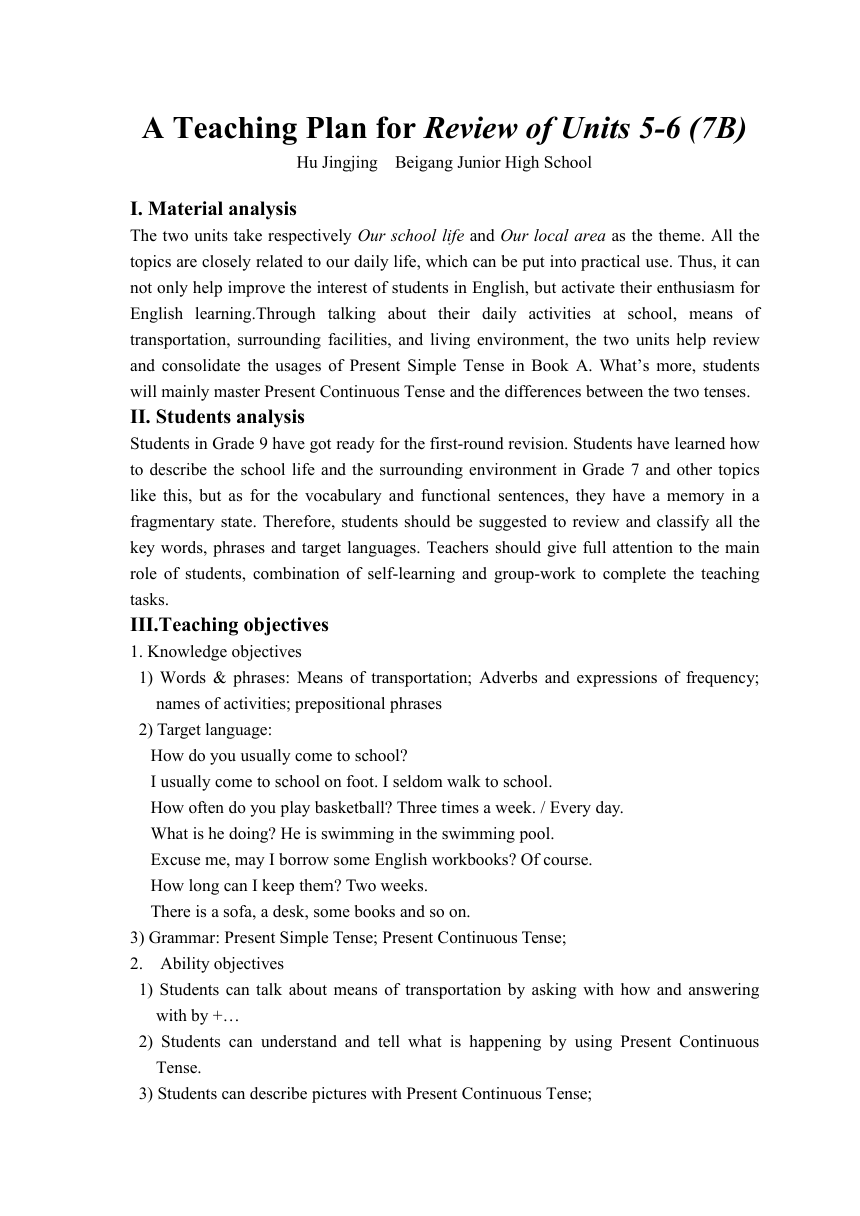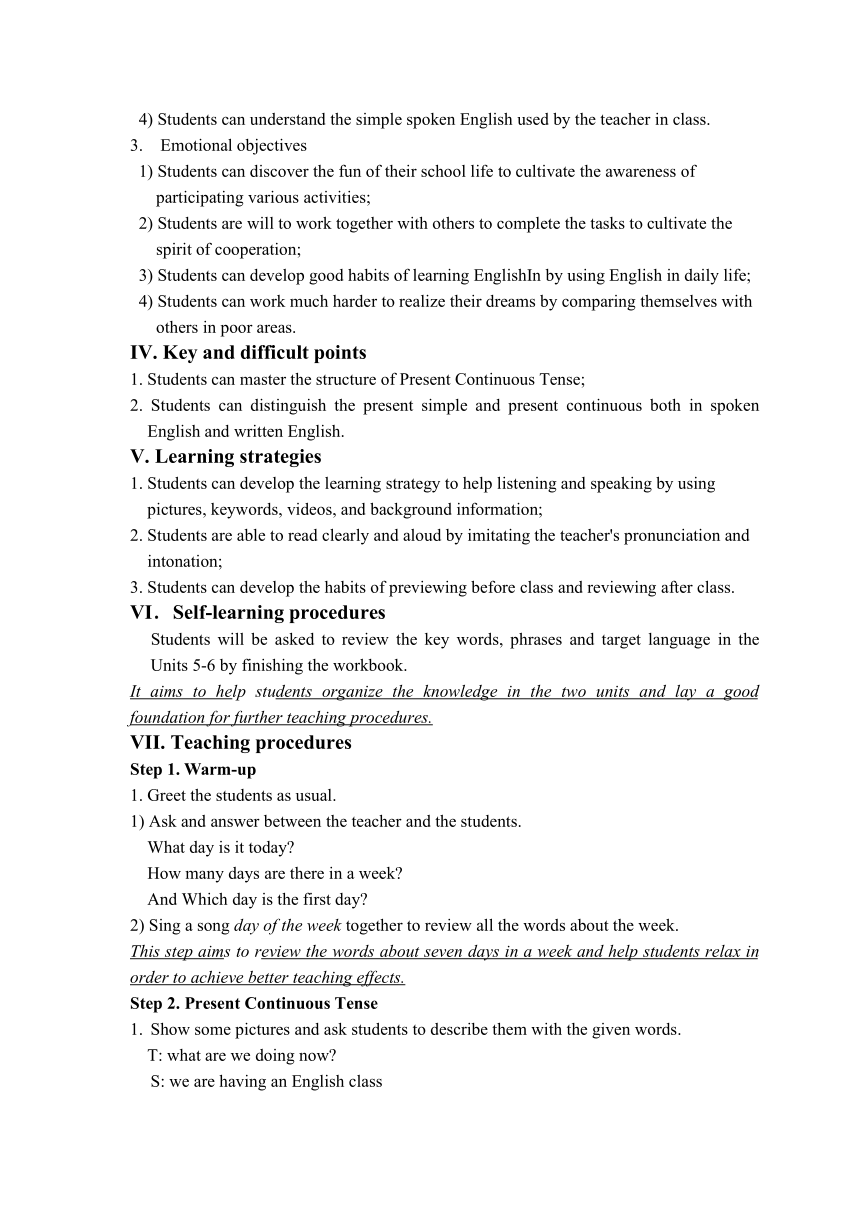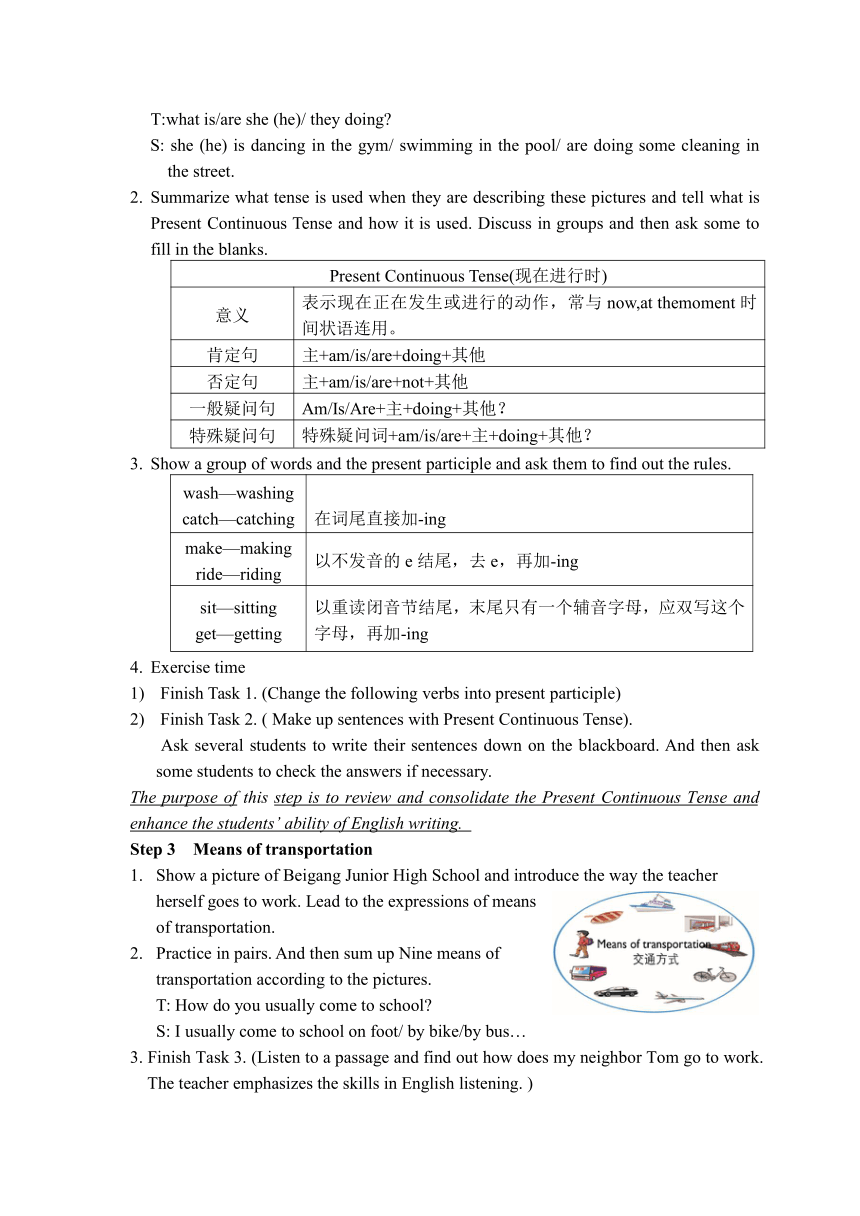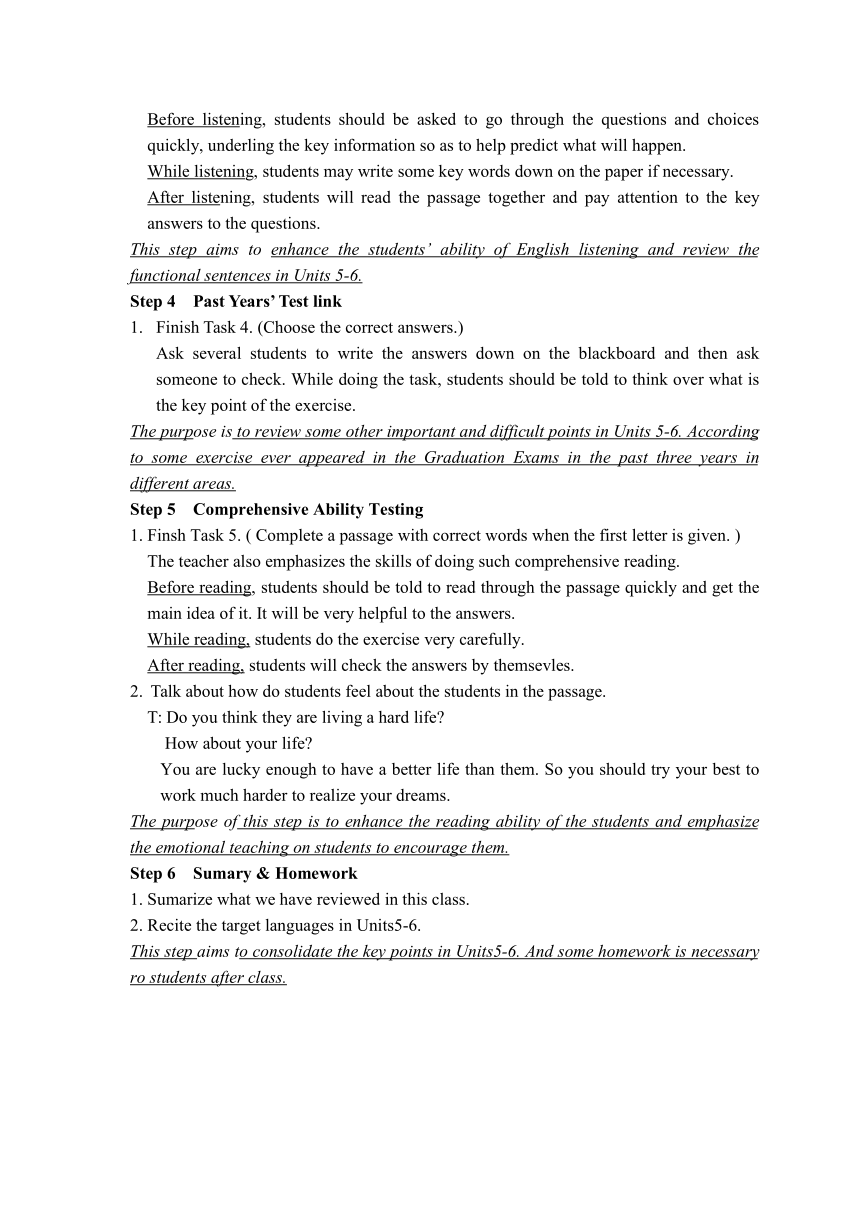仁爱科普版英语七年级下Review of Units 5-6 教学设计
文档属性
| 名称 | 仁爱科普版英语七年级下Review of Units 5-6 教学设计 |  | |
| 格式 | zip | ||
| 文件大小 | 361.8KB | ||
| 资源类型 | 教案 | ||
| 版本资源 | 仁爱科普版 | ||
| 科目 | 英语 | ||
| 更新时间 | 2018-04-15 15:59:47 | ||
图片预览




文档简介
A Teaching Plan for Review of Units 5-6 (7B)
Hu Jingjing Beigang Junior High School
I. Material analysis
The two units take respectively Our school life and Our local area as the theme. All the topics are closely related to our daily life, which can be put into practical use. Thus, it can not only help improve the interest of students in English, but activate their enthusiasm for English learning.Through talking about their daily activities at school, means of transportation, surrounding facilities, and living environment, the two units help review and consolidate the usages of Present Simple Tense in Book A. What’s more, students will mainly master Present Continuous Tense and the differences between the two tenses.
II. Students analysis
Students in Grade 9 have got ready for the first-round revision. Students have learned how to describe the school life and the surrounding environment in Grade 7 and other topics like this, but as for the vocabulary and functional sentences, they have a memory in a fragmentary state. Therefore, students should be suggested to review and classify all the key words, phrases and target languages. Teachers should give full attention to the main role of students, combination of self-learning and group-work to complete the teaching tasks.
III.Teaching objectives
1. Knowledge objectives
1) Words & phrases: Means of transportation; Adverbs and expressions of frequency; names of activities; prepositional phrases
2) Target language:
How do you usually come to school?
I usually come to school on foot. I seldom walk to school.
How often do you play basketball? Three times a week. / Every day.
What is he doing? He is swimming in the swimming pool.
Excuse me, may I borrow some English workbooks? Of course.
How long can I keep them? Two weeks.
There is a sofa, a desk, some books and so on.
3) Grammar: Present Simple Tense; Present Continuous Tense;
2. Ability objectives
1) Students can talk about means of transportation by asking with how and answering with by +…
2) Students can understand and tell what is happening by using Present Continuous Tense.
3) Students can describe pictures with Present Continuous Tense;
4) Students can understand the simple spoken English used by the teacher in class.
3. Emotional objectives
1) Students can discover the fun of their school life to cultivate the awareness of
participating various activities; 2) Students are will to work together with others to complete the tasks to cultivate the
spirit of cooperation; 3) Students can develop good habits of learning EnglishIn by using English in daily life;
4) Students can work much harder to realize their dreams by comparing themselves with
others in poor areas.
IV. Key and difficult points
1. Students can master the structure of Present Continuous Tense;
2. Students can distinguish the present simple and present continuous both in spoken English and written English.
V. Learning strategies
1. Students can develop the learning strategy to help listening and speaking by using
pictures, keywords, videos, and background information; 2. Students are able to read clearly and aloud by imitating the teacher's pronunciation and
intonation; 3. Students can develop the habits of previewing before class and reviewing after class.
VI.Self-learning procedures
Students will be asked to review the key words, phrases and target language in the Units 5-6 by finishing the workbook.
It aims to help students organize the knowledge in the two units and lay a good foundation for further teaching procedures.
VII. Teaching procedures
Step 1. Warm-up
1. Greet the students as usual.
1) Ask and answer between the teacher and the students.
What day is it today?
How many days are there in a week?
And Which day is the first day?
2) Sing a song day of the week together to review all the words about the week.
This step aims to review the words about seven days in a week and help students relax in order to achieve better teaching effects.
Step 2. Present Continuous Tense
Show some pictures and ask students to describe them with the given words.
T: what are we doing now?
S: we are having an English class
T:what is/are she (he)/ they doing?
S: she (he) is dancing in the gym/ swimming in the pool/ are doing some cleaning in the street.
Summarize what tense is used when they are describing these pictures and tell what is Present Continuous Tense and how it is used. Discuss in groups and then ask some to fill in the blanks.
Present Continuous Tense(现在进行时)
意义
表示现在正在发生或进行的动作,常与now,at themoment时间状语连用。
肯定句
主+am/is/are+doing+其他
否定句
主+am/is/are+not+其他
一般疑问句
Am/Is/Are+主+doing+其他?
特殊疑问句
特殊疑问词+am/is/are+主+doing+其他?
Show a group of words and the present participle and ask them to find out the rules.
wash—washing
catch—catching
在词尾直接加-ing
make—making
ride—riding
以不发音的e结尾,去e,再加-ing
sit—sitting
get—getting
以重读闭音节结尾,末尾只有一个辅音字母,应双写这个字母,再加-ing
Exercise time
Finish Task 1. (Change the following verbs into present participle)
Finish Task 2. ( Make up sentences with Present Continuous Tense).
Ask several students to write their sentences down on the blackboard. And then ask some students to check the answers if necessary.
The purpose of this step is to review and consolidate the Present Continuous Tense and enhance the students’ ability of English writing.
Step 3 Means of transportation
Show a picture of Beigang Junior High School and introduce the way the teacher
herself goes to work. Lead to the expressions of means
of transportation.
Practice in pairs. And then sum up Nine means of
transportation according to the pictures.
T: How do you usually come to school?
S: I usually come to school on foot/ by bike/by bus…
3. Finish Task 3. (Listen to a passage and find out how does my neighbor Tom go to work. The teacher emphasizes the skills in English listening. )
Before listening, students should be asked to go through the questions and choices quickly, underling the key information so as to help predict what will happen.
While listening, students may write some key words down on the paper if necessary.
After listening, students will read the passage together and pay attention to the key answers to the questions.
This step aims to enhance the students’ ability of English listening and review the functional sentences in Units 5-6.
Step 4 Past Years’ Test link
Finish Task 4. (Choose the correct answers.)
Ask several students to write the answers down on the blackboard and then ask someone to check. While doing the task, students should be told to think over what is the key point of the exercise.
The purpose is to review some other important and difficult points in Units 5-6. According to some exercise ever appeared in the Graduation Exams in the past three years in different areas.
Step 5 Comprehensive Ability Testing
1. Finsh Task 5. ( Complete a passage with correct words when the first letter is given. )
The teacher also emphasizes the skills of doing such comprehensive reading.
Before reading, students should be told to read through the passage quickly and get the main idea of it. It will be very helpful to the answers.
While reading, students do the exercise very carefully.
After reading, students will check the answers by themsevles.
Talk about how do students feel about the students in the passage.
T: Do you think they are living a hard life?
How about your life?
You are lucky enough to have a better life than them. So you should try your best to work much harder to realize your dreams.
The purpose of this step is to enhance the reading ability of the students and emphasize the emotional teaching on students to encourage them.
Step 6 Sumary & Homework
1. Sumarize what we have reviewed in this class.
2. Recite the target languages in Units5-6.
This step aims to consolidate the key points in Units5-6. And some homework is necessary ro students after class.
VII. Teaching reflection
1. 本堂课是中考第一轮复习中的一节复习课,以2017年咸宁市中考英语说明为指南,并结合近几年中考真题或对相关真题进行改编(如将2016年成都市的完形填空改编成为12个空的短文填词,并对部分信息进行了修改),有效地引导学生复习了仁爱英语七年级Unit5-6的重点单词短语句型和语法,让学生对中考中出现的部分较难题型及相关的解题技巧有所掌握,为第二轮复习专题训练中的解题方法的指导起到了重要的作用。
2. 这堂英语课利用了多种教法和学法相结合的方式,如任务型教学法,情景教学法,直观教学法,小组合作模式等方式有效地提高了课堂效率,充分复习了这两个单元的重难点,特别是在练习过程中,以学生为主体,面向不同层次的学生,通过中考真题的训练,教师指导学生分析题目,修正错误,总结规律,这也是课程改革形势下的新要求,也是学习新课标的一种新体验;
3. 整堂课的复习以设置的五项基本任务为主线,覆盖中考的四种基本题型(听力短文理解,单项选择,短文填词等),分别从听说读写四个方面进行内容的复习以及方法的指导,有一定的条理性,层次性,体现了由浅入深、由易到难、循序渐进的原则,不仅提高了他们的学习兴趣,还使得学生听说读写的能力得到了一定的提升;
4. 本堂课开始通过问答,合唱英文歌曲Day of the week等形式进行热身与导入,既消除了学生的紧张情绪,减轻英语学习的枯燥感,调动了学生的积极性,而且复习了Units5-6中关于星期的重点词汇;
5. 本堂课也存在一定的不足,如:
1)在讲解Task4单项选择时,应尽量使用英语进行讲解,理解教师课堂用语其实对学生来说并没有什么难度;教师课堂尽可能多的说英语对学生语言感知能力的培养有着积极的作用,也是学生学好英语,综合运用语言的基础。
2)Task5的设计应多预留出一些时间,一是可以让学生以小组的形式讨论之后进行讲解;二是最后全班可以对语篇进行完整的学习,自己谈论感受,而不是教师一味的进行灌输,从而达到真正意义上的情感教育的目的;
3)对于复习的七年级Units5-6这两个单元,内容较其他年级更简单,为了更接近于中考的难度,可以考虑将看图写作的Task2改成一篇更适合我们咸宁市中考英语中的作文进行练,且为了达到检测效果,演排的人数需要适当增加,从而可以从多个角度去发现学生写作中存在的问题,进而解决问题,提高学生的写作水平;
即使是一堂复习课,我们也应该在新鲜的语境中再现、巩固、总结所学相关知识。复习课依然要以话题为基点,以语言知识(语音、词汇、语法、功能、话题)的夯实为根本,提高学生的语言运用能力。?在中考复习中,应注重听、说、读、写四种语言技能的有机整合,复习课要在实际应用的层面上引导学生体验运用语言解决实际问题的过程,这对于发展九年级学生的综合语言运用能力具有重要的价值。
Review of Units 5-6
Task 1 写出下列动词的现在分词形式(-ing)。
1. play 2. shop 3. see 4. stop
5. take 6. write 7. teach 8. begin
Task 2 Write the sentences with Present Continuous Tense.(看图写句子)
__________________________________________________________
__________________________________________________________
Task 3 Listen and choose the correct answers.(听短文,选择正确答案。)
( ) 1. Where does Tom work?
A. In a bank B. In a bus station C. In a hospital
( ) 2. What does he usually do at 6:30 a.m.?
A. He gets up. B. He has breakfast C. He plays sports.
( ) 3. How does he go to work?
A. By bus B. By train C. On foot.
( ) 4. What is his wife?
A. A doctor B. A nurse C. A worker
( ) 5. What is he doing now?
A. He is walking along the river.
B. He is watching TV.
C. He is listening to music.
Task 4 Choose the correct answer.(单项选择)
( )1. (2015资阳)-Which of the two subjects do you like, art or music?
-______. They are really interesting.
A. Neither B.Both C.None D. All
( )2. (2016长沙)-_____is the World Cup held?
-Every four years.
A. How soon B. When C. How often D. How long
( )3. (2016广州) Hurry up, kids! The school bus is coming. We have ___ time left.
A. few B. a few C. little D. a little
( )4. (2014毕节) There___a book and some pens in the bag. Please give them to the old man.?
A. be? B. are? C. is? D. have
( )5. ( 2015天津) I?____ride a bike to school. But this morning, I __walked to school.?
A. never? B. hardly? C. seldom ?D. usually
( )6. (2016荆门) -Could you _ me your bike, Tom ?
- OK. And you can _ it for a week.
lend ; keep B. borrow; lend C. lend ; borrow D. borrow; keep
( ) 7. (2016咸宁)-Today's young people can't live without smart phones.
-They keep their hands on the phones wherever they go,even while they______meals.
A. have B. are having C.were having D.will have
Task 5(2016成都)Complete the passage. (短文填词)
How do you get to school every day?
For most students in cities,it's e_____ for them to get to school.They can walk or ride a bike to school.They can get to school by bus or even by s________. It won't t_____ them too long to get to school and back home.
But for some students in faraway villages,things are quite d_______.Life for them is hard.It's difficult for them to get to school every day.Usually they will spend a f______ hours on the way.
In one small village,there is a big river b______ the school and the village.The students can't get to school by boat because the river runs too q________.They have to go on a ropeway to c______ the big river.T_________ it's dangerous,they are used to it and are not afraid.In their mind, going out to study is one of their h_______ things. Because of the terrible transportation,many villagers n______ leave their village.How they are l________ forward to having a bridge! I hope one day their dream can come true.
Hu Jingjing Beigang Junior High School
I. Material analysis
The two units take respectively Our school life and Our local area as the theme. All the topics are closely related to our daily life, which can be put into practical use. Thus, it can not only help improve the interest of students in English, but activate their enthusiasm for English learning.Through talking about their daily activities at school, means of transportation, surrounding facilities, and living environment, the two units help review and consolidate the usages of Present Simple Tense in Book A. What’s more, students will mainly master Present Continuous Tense and the differences between the two tenses.
II. Students analysis
Students in Grade 9 have got ready for the first-round revision. Students have learned how to describe the school life and the surrounding environment in Grade 7 and other topics like this, but as for the vocabulary and functional sentences, they have a memory in a fragmentary state. Therefore, students should be suggested to review and classify all the key words, phrases and target languages. Teachers should give full attention to the main role of students, combination of self-learning and group-work to complete the teaching tasks.
III.Teaching objectives
1. Knowledge objectives
1) Words & phrases: Means of transportation; Adverbs and expressions of frequency; names of activities; prepositional phrases
2) Target language:
How do you usually come to school?
I usually come to school on foot. I seldom walk to school.
How often do you play basketball? Three times a week. / Every day.
What is he doing? He is swimming in the swimming pool.
Excuse me, may I borrow some English workbooks? Of course.
How long can I keep them? Two weeks.
There is a sofa, a desk, some books and so on.
3) Grammar: Present Simple Tense; Present Continuous Tense;
2. Ability objectives
1) Students can talk about means of transportation by asking with how and answering with by +…
2) Students can understand and tell what is happening by using Present Continuous Tense.
3) Students can describe pictures with Present Continuous Tense;
4) Students can understand the simple spoken English used by the teacher in class.
3. Emotional objectives
1) Students can discover the fun of their school life to cultivate the awareness of
participating various activities; 2) Students are will to work together with others to complete the tasks to cultivate the
spirit of cooperation; 3) Students can develop good habits of learning EnglishIn by using English in daily life;
4) Students can work much harder to realize their dreams by comparing themselves with
others in poor areas.
IV. Key and difficult points
1. Students can master the structure of Present Continuous Tense;
2. Students can distinguish the present simple and present continuous both in spoken English and written English.
V. Learning strategies
1. Students can develop the learning strategy to help listening and speaking by using
pictures, keywords, videos, and background information; 2. Students are able to read clearly and aloud by imitating the teacher's pronunciation and
intonation; 3. Students can develop the habits of previewing before class and reviewing after class.
VI.Self-learning procedures
Students will be asked to review the key words, phrases and target language in the Units 5-6 by finishing the workbook.
It aims to help students organize the knowledge in the two units and lay a good foundation for further teaching procedures.
VII. Teaching procedures
Step 1. Warm-up
1. Greet the students as usual.
1) Ask and answer between the teacher and the students.
What day is it today?
How many days are there in a week?
And Which day is the first day?
2) Sing a song day of the week together to review all the words about the week.
This step aims to review the words about seven days in a week and help students relax in order to achieve better teaching effects.
Step 2. Present Continuous Tense
Show some pictures and ask students to describe them with the given words.
T: what are we doing now?
S: we are having an English class
T:what is/are she (he)/ they doing?
S: she (he) is dancing in the gym/ swimming in the pool/ are doing some cleaning in the street.
Summarize what tense is used when they are describing these pictures and tell what is Present Continuous Tense and how it is used. Discuss in groups and then ask some to fill in the blanks.
Present Continuous Tense(现在进行时)
意义
表示现在正在发生或进行的动作,常与now,at themoment时间状语连用。
肯定句
主+am/is/are+doing+其他
否定句
主+am/is/are+not+其他
一般疑问句
Am/Is/Are+主+doing+其他?
特殊疑问句
特殊疑问词+am/is/are+主+doing+其他?
Show a group of words and the present participle and ask them to find out the rules.
wash—washing
catch—catching
在词尾直接加-ing
make—making
ride—riding
以不发音的e结尾,去e,再加-ing
sit—sitting
get—getting
以重读闭音节结尾,末尾只有一个辅音字母,应双写这个字母,再加-ing
Exercise time
Finish Task 1. (Change the following verbs into present participle)
Finish Task 2. ( Make up sentences with Present Continuous Tense).
Ask several students to write their sentences down on the blackboard. And then ask some students to check the answers if necessary.
The purpose of this step is to review and consolidate the Present Continuous Tense and enhance the students’ ability of English writing.
Step 3 Means of transportation
Show a picture of Beigang Junior High School and introduce the way the teacher
herself goes to work. Lead to the expressions of means
of transportation.
Practice in pairs. And then sum up Nine means of
transportation according to the pictures.
T: How do you usually come to school?
S: I usually come to school on foot/ by bike/by bus…
3. Finish Task 3. (Listen to a passage and find out how does my neighbor Tom go to work. The teacher emphasizes the skills in English listening. )
Before listening, students should be asked to go through the questions and choices quickly, underling the key information so as to help predict what will happen.
While listening, students may write some key words down on the paper if necessary.
After listening, students will read the passage together and pay attention to the key answers to the questions.
This step aims to enhance the students’ ability of English listening and review the functional sentences in Units 5-6.
Step 4 Past Years’ Test link
Finish Task 4. (Choose the correct answers.)
Ask several students to write the answers down on the blackboard and then ask someone to check. While doing the task, students should be told to think over what is the key point of the exercise.
The purpose is to review some other important and difficult points in Units 5-6. According to some exercise ever appeared in the Graduation Exams in the past three years in different areas.
Step 5 Comprehensive Ability Testing
1. Finsh Task 5. ( Complete a passage with correct words when the first letter is given. )
The teacher also emphasizes the skills of doing such comprehensive reading.
Before reading, students should be told to read through the passage quickly and get the main idea of it. It will be very helpful to the answers.
While reading, students do the exercise very carefully.
After reading, students will check the answers by themsevles.
Talk about how do students feel about the students in the passage.
T: Do you think they are living a hard life?
How about your life?
You are lucky enough to have a better life than them. So you should try your best to work much harder to realize your dreams.
The purpose of this step is to enhance the reading ability of the students and emphasize the emotional teaching on students to encourage them.
Step 6 Sumary & Homework
1. Sumarize what we have reviewed in this class.
2. Recite the target languages in Units5-6.
This step aims to consolidate the key points in Units5-6. And some homework is necessary ro students after class.
VII. Teaching reflection
1. 本堂课是中考第一轮复习中的一节复习课,以2017年咸宁市中考英语说明为指南,并结合近几年中考真题或对相关真题进行改编(如将2016年成都市的完形填空改编成为12个空的短文填词,并对部分信息进行了修改),有效地引导学生复习了仁爱英语七年级Unit5-6的重点单词短语句型和语法,让学生对中考中出现的部分较难题型及相关的解题技巧有所掌握,为第二轮复习专题训练中的解题方法的指导起到了重要的作用。
2. 这堂英语课利用了多种教法和学法相结合的方式,如任务型教学法,情景教学法,直观教学法,小组合作模式等方式有效地提高了课堂效率,充分复习了这两个单元的重难点,特别是在练习过程中,以学生为主体,面向不同层次的学生,通过中考真题的训练,教师指导学生分析题目,修正错误,总结规律,这也是课程改革形势下的新要求,也是学习新课标的一种新体验;
3. 整堂课的复习以设置的五项基本任务为主线,覆盖中考的四种基本题型(听力短文理解,单项选择,短文填词等),分别从听说读写四个方面进行内容的复习以及方法的指导,有一定的条理性,层次性,体现了由浅入深、由易到难、循序渐进的原则,不仅提高了他们的学习兴趣,还使得学生听说读写的能力得到了一定的提升;
4. 本堂课开始通过问答,合唱英文歌曲Day of the week等形式进行热身与导入,既消除了学生的紧张情绪,减轻英语学习的枯燥感,调动了学生的积极性,而且复习了Units5-6中关于星期的重点词汇;
5. 本堂课也存在一定的不足,如:
1)在讲解Task4单项选择时,应尽量使用英语进行讲解,理解教师课堂用语其实对学生来说并没有什么难度;教师课堂尽可能多的说英语对学生语言感知能力的培养有着积极的作用,也是学生学好英语,综合运用语言的基础。
2)Task5的设计应多预留出一些时间,一是可以让学生以小组的形式讨论之后进行讲解;二是最后全班可以对语篇进行完整的学习,自己谈论感受,而不是教师一味的进行灌输,从而达到真正意义上的情感教育的目的;
3)对于复习的七年级Units5-6这两个单元,内容较其他年级更简单,为了更接近于中考的难度,可以考虑将看图写作的Task2改成一篇更适合我们咸宁市中考英语中的作文进行练,且为了达到检测效果,演排的人数需要适当增加,从而可以从多个角度去发现学生写作中存在的问题,进而解决问题,提高学生的写作水平;
即使是一堂复习课,我们也应该在新鲜的语境中再现、巩固、总结所学相关知识。复习课依然要以话题为基点,以语言知识(语音、词汇、语法、功能、话题)的夯实为根本,提高学生的语言运用能力。?在中考复习中,应注重听、说、读、写四种语言技能的有机整合,复习课要在实际应用的层面上引导学生体验运用语言解决实际问题的过程,这对于发展九年级学生的综合语言运用能力具有重要的价值。
Review of Units 5-6
Task 1 写出下列动词的现在分词形式(-ing)。
1. play 2. shop 3. see 4. stop
5. take 6. write 7. teach 8. begin
Task 2 Write the sentences with Present Continuous Tense.(看图写句子)
__________________________________________________________
__________________________________________________________
Task 3 Listen and choose the correct answers.(听短文,选择正确答案。)
( ) 1. Where does Tom work?
A. In a bank B. In a bus station C. In a hospital
( ) 2. What does he usually do at 6:30 a.m.?
A. He gets up. B. He has breakfast C. He plays sports.
( ) 3. How does he go to work?
A. By bus B. By train C. On foot.
( ) 4. What is his wife?
A. A doctor B. A nurse C. A worker
( ) 5. What is he doing now?
A. He is walking along the river.
B. He is watching TV.
C. He is listening to music.
Task 4 Choose the correct answer.(单项选择)
( )1. (2015资阳)-Which of the two subjects do you like, art or music?
-______. They are really interesting.
A. Neither B.Both C.None D. All
( )2. (2016长沙)-_____is the World Cup held?
-Every four years.
A. How soon B. When C. How often D. How long
( )3. (2016广州) Hurry up, kids! The school bus is coming. We have ___ time left.
A. few B. a few C. little D. a little
( )4. (2014毕节) There___a book and some pens in the bag. Please give them to the old man.?
A. be? B. are? C. is? D. have
( )5. ( 2015天津) I?____ride a bike to school. But this morning, I __walked to school.?
A. never? B. hardly? C. seldom ?D. usually
( )6. (2016荆门) -Could you _ me your bike, Tom ?
- OK. And you can _ it for a week.
lend ; keep B. borrow; lend C. lend ; borrow D. borrow; keep
( ) 7. (2016咸宁)-Today's young people can't live without smart phones.
-They keep their hands on the phones wherever they go,even while they______meals.
A. have B. are having C.were having D.will have
Task 5(2016成都)Complete the passage. (短文填词)
How do you get to school every day?
For most students in cities,it's e_____ for them to get to school.They can walk or ride a bike to school.They can get to school by bus or even by s________. It won't t_____ them too long to get to school and back home.
But for some students in faraway villages,things are quite d_______.Life for them is hard.It's difficult for them to get to school every day.Usually they will spend a f______ hours on the way.
In one small village,there is a big river b______ the school and the village.The students can't get to school by boat because the river runs too q________.They have to go on a ropeway to c______ the big river.T_________ it's dangerous,they are used to it and are not afraid.In their mind, going out to study is one of their h_______ things. Because of the terrible transportation,many villagers n______ leave their village.How they are l________ forward to having a bridge! I hope one day their dream can come true.
同课章节目录
- Unit 5 Our school life
- Topic 1 I usually come to school by subway.
- Topic 2 A few students are running around the play
- Topic 3 My school life is very interesting.
- Unit 6 Our local area
- Topic 1 Is there a computer in your study?
- Topic 2 My home is in an apartment building.
- Topic 3 Which is the way to the hospital?
- Review of Units 5-6
- Unit 7 The Birthday
- Topic 1 When is your birthday?
- Topic 2 Can you sing an English song?
- Topic 3 Everyone had a good time.
- Unit 8 The seasons and the Weathe
- Topic 1 What's the weather like in summer?
- Topic 2 The summer holidays are coming.
- Topic 3 Let’s celebrate!
- Review of Units 7-8
- 旧版资料
- Unit 5 Our School Life
- Unit 6 Our Local Area
- Unit 7 The Birthday
- Unit 8 The seasons and the Weathe
- Unit 7 Celebrating the Birthday(老版本)
